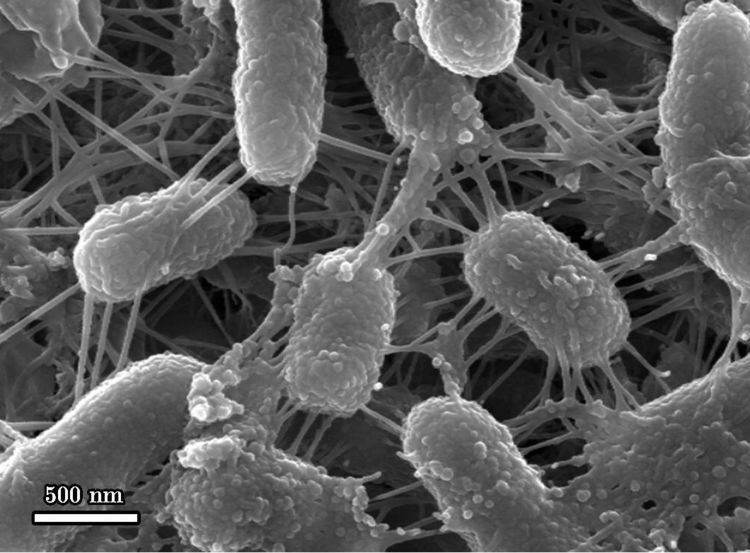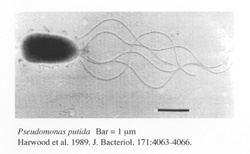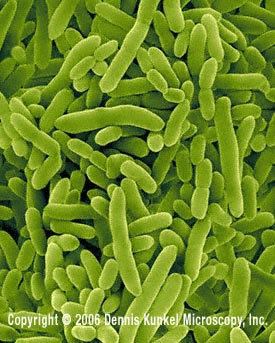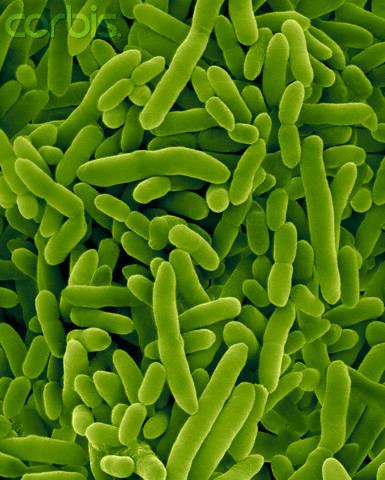Scientific name Pseudomonas putida Rank Species | ||
 | ||
Similar Pseudomonas, Bacteria, Pseudomonas fluorescens, Rhodococcus, Pseudomonas stutzeri | ||
Bacteria on the fungal highway pseudomonas putida moving along hyphae of cunninghamella elegans
Pseudomonas putida is a Gram-negative, rod-shaped, saprotrophic soil bacterium. Based on 16S rRNA analysis, P. putida was taxonomically confirmed to be a Pseudomonas species (sensu stricto) and placed, along with several other species, in the P. putida group, to which it lends its name.
Contents
- Bacteria on the fungal highway pseudomonas putida moving along hyphae of cunninghamella elegans
- Pseudomonas putida
- Bioremediation
- Biocontrol
- Oligonucleotide usage signatures of the P putida KT2440 genome
- Organic synthesis
- CBB5 and caffeine consumption
- References
A variety of P. putida, called multiplasmid hydrocarbon-degrading Pseudomonas, is the first patented organism in the world. Because it is a living organism, the patent was disputed and brought before the United States Supreme Court in the historic court case Diamond v. Chakrabarty, which the inventor, Ananda Mohan Chakrabarty, won. It demonstrates a very diverse metabolism, including the ability to degrade organic solvents such as toluene. This ability has been put to use in bioremediation, or the use of microorganisms to biodegrade oil. Use of P. putida is preferable to some other Pseudomonas species capable of such degradation, as it is a safe species of bacteria, unlike P. aeruginosa, for example, which is an opportunistic human pathogen.

Pseudomonas putida
Bioremediation

The diverse metabolism of wild-type strains of P. putida may be exploited for bioremediation; for example, it has been shown in the laboratory to function as a soil inoculant to remedy naphthalene-contaminated soils.

P. putida is capable of converting styrene oil into the biodegradable plastic PHA. This may be of use in the effective recycling of polystyrene foam, otherwise thought to be not biodegradable.
Biocontrol
P. putida has demonstrated potential biocontrol properties, as an effective antagonist of damping off diseases such as Pythium and Fusarium.
Oligonucleotide usage signatures of the P. putida KT2440 genome

Di- to pentanucleotide usage and the list of the most abundant octa- to tetradecanucleotides are useful measures of the bacterial genomic signature. The P. putida KT2440 chromosome is characterized by strand symmetry and intrastrand parity of complementary oligonucleotides. Each tetranucleotide occurs with similar frequency on the two strands. Tetranucleotide usage is biased by G+C content and physicochemical constraints such as base stacking energy, dinucleotide propeller twist angle, or trinucleotide bendability. The 105 regions with atypical oligonucleotide composition can be differentiated by their patterns of oligonucleotide usage into categories of horizontally acquired gene islands, multidomain genes or ancient regions such as genes for ribosomal proteins and RNAs. A species-specific extragenic palindromic sequence is the most common repeat in the genome that can be exploited for the typing of P. putida strains. In the coding sequence of P. putida, LLL is the most abundant tripeptide.
Organic synthesis

P. putida's amenability to genetic manipulation has allowed it to be used in the synthesis of numerous organic pharmaceutical and agricultural compounds from various substrates.
CBB5 and caffeine consumption
P. putida CBB5, a nonengineered, wild-type variety found in soil, can live on pure caffeine and has been observed to break caffeine down into carbon dioxide and ammonia.
